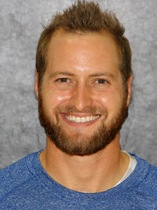
The Hillsdale College athletic department recently hired Mitchell Schoenborn to take over as Strength and Conditioning coach. Schoenborn replaces Mitchell Faine, who was hired in the summer. Schoenborn is the third coach to hold the position in the calendar year.
His job requires he do a little bit of everything, from managing players’ nutrition, designing and implementing the training program for seven sports, and training athletes based on their sport. Some sports require more or less of his help due to each head coach’s ability and involvement, but Schoenborn is involved in some capacity with football, softball, volleyball, golf, track and field, women’s basketball, and volleyball.
The position requires him to help players get in their best shape, and that doesn’t stop when they leave the weight room. Each week, Schoenborn talks to Bon Appetit to get the week’s menu and decide what athletes should eat. He posts the menu to Hillsdale’s nutrition Twitter account, @FuelChargers. Food choices are important to ensure their recovery from workouts, so Schoenborn chooses food with limited processed fat and plenty of protein, he said.
For some sports, such as swimming, the coaches take over after Schoenborn creates the programming and training. Director of Sports Medicine and Performance, Tyler Cortight, trains the volleyball team right now, but Schoenborn plans to transition as the team’s trainer.
One team he works with in all aspects of training is football. Before practices and games, he helps them prepare to take the field. He typically has the team stretch and meditate in the hotel conference room before games.
What he does with them depends on the day. Because the team’s roster is so large, he practices with those who travel, typically first-string players, and those who don’t travel, typically redshirt freshman and injured players.
His schedule, however, is constantly changing. Working with so many groups reflects in his routine as some sports are transitioning into their off-season. During the season, athletes are only allowed to dedicate 20 hours to their sport, Schoenborn said, so they spend more time practicing their game than they do on conditioning their bodies. So athletes typically train for four hours in season versus eight hours when not in season.
Schoenborn said he likes working at Hillsdale because of how appreciative and cooperative the athletes are.
“They listen well,” he said. “No prodding needed. They want to get better.”
And he expects them to give 100% to each workout. Schoenborn’s mantra is, “How you do anything is how you do everything.” The way athletes practice, he said, is going to reflect how they play on gameday. It goes beyond practice, too. Schoenborn said how players behave outside of their sport shows their character and ability as much as their athletic endeavors.
Schoenborn’s known for a long time he wanted to be a trainer and all that comes with the job.
“Not many jobs allow you to wear sweatpants to work everyday,” he said with a laugh.
Schoenborn began his career as a trainer as an assistant at Central Michigan University where he received his undergraduate and graduate degrees in exercise psychology. He started as an undergraduate assistant for football and track that he continued for his first year into his graduate studies. His second year, he took over track and field and wrestling.
The most rewarding part about his job is building a bond with students that goes beyond their physical health, but addresses their mental and emotional health.
“I’ll ask students ‘How did that biology exam go?’ or ‘How’s your mom?’ he said. “I get to care about their well-being.”
Different people work best with different learning styles, and he said he enjoys finding what works best for different people. He says it’s an art form, finding how to tailor workouts to various audio, visual, and tactile learners, and it’s extremely fulfilling for Schoenborn.
The transition has been smooth, he said. Most aspects of his job have stayed the same, but he made some small changes from how the former Head Strength and Conditioning Coach Patrick Gifford operated. One thing he does differently is leaving the equipment out for the different groups to save time.
“Those three or four minutes when you only have 45 minutes with the team can eat up a lot of time,” he said. “You really need to be efficient.”
He has small changes in mind for the future, including incorporating kettlebells further into workouts for all his sports. He is a strong advocate for kettlebells as he said they help develop coordination and focus.
There haven’t been any big challenges so far, despite this being Schoenborn’s first time programming for football. Schoenborn said one potential problem with changing hands is confusion with the players, but that hasn’t been an issue as they try to understand his instruction well.
“They all try really hard,” he said. “They listen to the details and it’s going really well.”

